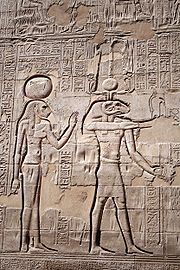
Menhit
Encyclopedia

Egyptian mythology
Ancient Egyptian religion was a complex system of polytheistic beliefs and rituals which were an integral part of ancient Egyptian society. It centered on the Egyptians' interaction with a multitude of deities who were believed to be present in, and in control of, the forces and elements of nature...
, Menhit (also spelt Menchit) was originally a foreign war
War
War is a state of organized, armed, and often prolonged conflict carried on between states, nations, or other parties typified by extreme aggression, social disruption, and usually high mortality. War should be understood as an actual, intentional and widespread armed conflict between political...
goddess. Her name depicts a warrior status, as it means (she who) massacres.
When included among the Egyptian deities, she became the female counterpart of Anhur
Anhur
In early Egyptian mythology, Anhur was originally a god of war who was worshipped in the Egyptian area of Abydos, and particularly in Thinis...
. It was said that she had come from Nubia
Nubia
Nubia is a region along the Nile river, which is located in northern Sudan and southern Egypt.There were a number of small Nubian kingdoms throughout the Middle Ages, the last of which collapsed in 1504, when Nubia became divided between Egypt and the Sennar sultanate resulting in the Arabization...
with Anhur who had been her counterpart and husband there.
Due to the aggressive attributes possessed by and hunting methods used by lion
Lion
The lion is one of the four big cats in the genus Panthera, and a member of the family Felidae. With some males exceeding 250 kg in weight, it is the second-largest living cat after the tiger...
esses, most things connected to warfare in Egypt were depicted as leonine, and Menhit was no exception, being depicted as a lion
Lion
The lion is one of the four big cats in the genus Panthera, and a member of the family Felidae. With some males exceeding 250 kg in weight, it is the second-largest living cat after the tiger...
ess-goddess
Goddess
A goddess is a female deity. In some cultures goddesses are associated with Earth, motherhood, love, and the household. In other cultures, goddesses also rule over war, death, and destruction as well as healing....
.
She also was believed to advance ahead of the Egyptian armies and cut down their enemies with fiery arrows, similar to other war deities She was less known to the people as Crown goddess..
In the 3rd Nome
Nome (Egypt)
A nome was a subnational administrative division of ancient Egypt. Today's use of the Greek nome rather than the Egyptian term sepat came about during the Ptolemaic period. Fascinated with Egypt, Greeks created many historical records about the country...
of Upper Egypt
Upper Egypt
Upper Egypt is the strip of land, on both sides of the Nile valley, that extends from the cataract boundaries of modern-day Aswan north to the area between El-Ayait and Zawyet Dahshur . The northern section of Upper Egypt, between El-Ayait and Sohag is sometimes known as Middle Egypt...
, particularly at Esna
Esna
Esna , known to the ancient Egyptians as Egyptian: Iunyt or Ta-senet; Greek: or or ; Latin: Lato, is a city in Egypt. It is located on the west bank of the River Nile, some 55 km south of Luxor...
, Menhit was said to be the wife of Khnum and the mother of Heka
Heka (god)
In Egyptian mythology, Heka was the deification of magic, his name being the Egyptian word for magic. According to Egyptian writing , Heka existed "before duality had yet come into being." The term "Heka" was also used for the practice of magical ritual...
.
As the centre of her cult was toward the southern border of Egypt, in Upper Egypt
Upper Egypt
Upper Egypt is the strip of land, on both sides of the Nile valley, that extends from the cataract boundaries of modern-day Aswan north to the area between El-Ayait and Zawyet Dahshur . The northern section of Upper Egypt, between El-Ayait and Sohag is sometimes known as Middle Egypt...
, she became strongly identified with Sekhmet
Sekhmet
In Egyptian mythology, Sekhmet , was originally the warrior goddess as well as goddess of healing for Upper Egypt. She is depicted as a lioness, the fiercest hunter known to the Egyptians. It was said that her breath created the desert...
, who was originally the lion-goddess of war for Upper Egypt, after unification of the two Egyptian kingdoms, this goddess began to be considered simply another aspect of Sekhmet.
Literature
- Rolf Felde: Ägyptische Gottheiten. Wiesbaden 1995
- Hans Bonnet: Lexikon der ägyptischen Religionsgeschichte, Hamburg 2000; ISBN 3-937872-08-6

